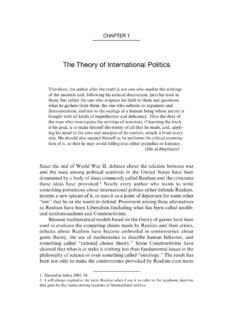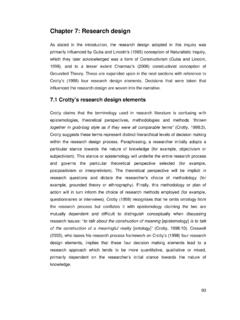Transcription of STRATEGIC COLLECTIVE BARGAINING
1 AN INTRODUCTION FOR EMPLOYERS STRATEGIC COLLECTIVEBARGAININGINTERNATIONAL ORGANISATION OF EMPLOYERS CONTENTS MODULE 1 - INTRODUCTION .. 1 Overview .. 1 What is COLLECTIVE BARGAINING ? .. 2 Why Enter into COLLECTIVE BARGAINING .. 6 The Risks of COLLECTIVE BARGAINING .. 8 The Aim of COLLECTIVE BARGAINING For Employers .. 9 Options for BARGAINING .. 10 The Pros and Cons of Multi-Employer COLLECTIVE BARGAINING .. 11 What is STRATEGIC COLLECTIVE BARGAINING ? .. 16 The COLLECTIVE BARGAINING Process / This Guide .. 17 Key Lessons .. 18 MODULE 2 STRATEGIC COLLECTIVE BARGAINING .. 21 Introduction .. 21 Preparing for COLLECTIVE BARGAINING .. 24 COLLECTIVE BARGAINING Strategy .. 28 Have Your Own Claims .. 31 Performance or Incentive Based Pay .. 33 Be Pragmatic and Realistic .. 37 Longer Term Strategy .. 39 Obstacles to Successful COLLECTIVE BARGAINING .. 40 Partnership With Your Employers Association.
2 41 Key Lessons .. 42 MODULE 3 - THE LAW .. 43 Introduction .. 43 Navigating the Law of COLLECTIVE BARGAINING .. 46 Industrial Action .. 47 Freedom of Association .. 50 The ILO .. 52 Key Lessons .. 52 MODULE 4 - NEGOTIATION .. 55 Introduction .. 55 Negotiation 56 Negotiation Phases .. 65 The Approach To Negotiation .. 71 Negotiation Tactics .. 77 Negotiation Psychology .. 86 Employer Negotiating Behaviour .. 89 Key Lessons .. 91 MODULE 5 WRITTEN COLLECTIVE AGREEMENT .. 93 Introduction .. 93 Why Use a Written Agreement .. 94 What Makes a Good Written Agreement .. 97 Agreement Approval / Voting .. 102 Communicating With Your Employees .. 108 Dealing with Disputes During the Life of the Agreement .. 110 Enforcement .. 116 Checklist of Important Matters for any COLLECTIVE Agreement .. 117 Key Lessons .. 118 MODULE 6 IMPLEMENTATION, EVALUATION & RENEGOTIATION .. 119 Introduction.
3 119 Implementation .. 120 Monitoring and Continuous Improvement .. 123 Communication .. 126 Renegotiation .. 126 Length of Agreement / Expiry Date .. 131 Dispute 136 Political Dimension .. 136 Key Lessons .. 139 ATTACHMENT A - GLOSSARY OF TERMS .. 141 ATTACHMENT B - LABOUR MANAGEMENT PLAN .. 145 MODULE 1 - INTRODUCTION 1 MODULE 1- INTRODUCTION OVERVIEW This Guide provides a basic introduction to COLLECTIVE BARGAINING . It seeks to provide practical advice and ideas to employers either BARGAINING for the first time, or seeking to get more out of the COLLECTIVE BARGAINING process. It has been prepared for employers, by employers. This is a joint project of the International Labour Organisation s Bureau for Employers Activities (ACTEMP) and the International Organisation of Employers (IOE). The Guide aims to give employers critical tools to get the most out of COLLECTIVE BARGAINING and use this process to their best commercial and operational advantage.
4 It contains a number of practical ideas and approaches, reflecting best practice and experience across a number of COLLECTIVE negotiations and a number of national systems. The Guide supports the STRATEGIC COLLECTIVE BARGAINING Training Program being delivered in the Asian region during September 2009. The Guide and Training Materials have been designed to work together as an integrated package. The Guide provides more information on the ideas and concepts introduced in the training program for employers to take back to their workplaces. Both the Guide and the Training Program have been organised into six (6) Modules: a. Module 1: Introduction This introduces the COLLECTIVE BARGAINING concept, the benefits of COLLECTIVE BARGAINING and what employers should be seeking to get out of this process. It also introduces various key options for enterprise BARGAINING , and the importance of approaching BARGAINING strategically to get the most out of it as an employer.
5 B. Module 2: STRATEGIC COLLECTIVE BARGAINING This outlines a STRATEGIC model to ensure employers can get the most out of the COLLECTIVE BARGAINING process for their business. There is an emphasis on tools to improve your productivity, efficiency and competitiveness. There is also an emphasis on effective planning and preparation. MODULE 1 - INTRODUCTION 2 c. Module 3: The Law Complying with the law is critical for successful COLLECTIVE BARGAINING and also offers the prospect of improving commercial outcomes for employers in many cases. Module 3 outlines an approach for ensuring legal compliance and harnessing what assistance your national legal system may offer. d. Module 4: Negotiation Negotiations lie at the heart of COLLECTIVE BARGAINING . Getting the most out negotiations is critical to getting the best possible outcomes for your business. Module 4 outlines some practical negotiation skills and tactics to equip employers to enter negotiations effectively and strategically.
6 It identifies both good practices and mistakes to avoid in the negotiation process. e. Module 5: Written COLLECTIVE Agreement Creating an effective and enforceable written agreement from your COLLECTIVE negotiations (the COLLECTIVE agreement) is critical. This is the key finished product of the COLLECTIVE BARGAINING process, most clearly visible to you and your employees. Module 5 outlines what makes an effective written COLLECTIVE agreement and provides some practical ideas to ensure you get the most out of this stage of the process. f. Module 6: Implementation, Evaluation and Renegotiation Finally, COLLECTIVE BARGAINING is an ongoing process. The concluding module outlines considerations for the implementation, evaluation and renegotiation of your COLLECTIVE agreement to ensure COLLECTIVE BARGAINING continues to make the best possible contribution to your commercial operations. The Guide is generic in nature and deals generally with COLLECTIVE BARGAINING across a wide range of national systems.
7 Advice may need to be sought at the national level on the application of some of the concepts and options included in the Guide in your national system. WHAT IS COLLECTIVE BARGAINING ? COLLECTIVE BARGAINING is a process of determining the terms and conditions of employment in your workplace by agreement with your employees. MODULE 1 - INTRODUCTION 3 The key elements of COLLECTIVE BARGAINING are: a. COLLECTIVE BARGAINING is a process. Employers should understand this process, understand the opportunities it presents and use it strategically. National laws will generally regulate this process, and it is important to know what the law does and does not allow (Module 3). b. COLLECTIVE BARGAINING is about the terms and conditions of employment. This means negotiations on wages, bonuses and allowances, terms and conditions of employment, hours of work, rosters etc. c. COLLECTIVE BARGAINING is a tool to regulate conditions of employment.
8 It is a means to achieve outcomes beneficial to your business. Just like any other commercial activity, you as an employer need to use it to your benefit. d. The outcome of COLLECTIVE BARGAINING should be an agreement between the employer and employees on the terms and conditions of employment (the COLLECTIVE Agreement). Not all negotiations will result in an agreement, but generally successful COLLECTIVE BARGAINING is finalised by the making of a written COLLECTIVE agreement (this is required practice for good COLLECTIVE BARGAINING and protecting your interests as an employer). At all times, COLLECTIVE BARGAINING must be viewed as a tool. a. Employers: It is a tool which employers use to set the terms and conditions of work. It is a tool which employers can use to pursue their STRATEGIC and commercial goals, and to implement STRATEGIC plans such as the Labour Management Plan in Attachment B. COLLECTIVE BARGAINING and COLLECTIVE agreements can also be useful in standardising the administration of employment, and simplifying how you manage and employ your staff.
9 B. Employees: It is a tool which employees use to set terms and conditions of employment which become the legal obligation of the employer. COLLECTIVE BARGAINING is a tool that employees use to address their priorities, increase benefits, and pursue job security. c. Governments: It is a tool which governments use to ensure that working conditions are fair, enjoy the support of employers and employees, and can be negotiated with a minimum of disruption to society and to the economy. MODULE 1 - INTRODUCTION 4 COLLECTIVE BARGAINING is one tool amongst many potentially available to your business. Depending on your national system and national legislation, employers may have a range of options for how work is organised and regulated. In partnership with your employers organisation, you can adapt the lessons in this guide to suit the needs of your business. Regardless of how big your business is, how many staff you employ, and whether you have previously participated in COLLECTIVE BARGAINING , this Guide will offer useful ideas and checklists for you to consider, and practical advice on approaching the COLLECTIVE BARGAINING process and getting the most out of it.
10 COLLECTIVE BARGAINING developed as an alternative to ad hoc employee claims and industrial instability. (Done well) it is a process which allows employees to secure additional rights and benefits, and also allows employers to manage this process, ensure their operations remain commercially viable, and to plan and budget employment costs into the future. It offers scope for substantial mutual gains for employers and employees, and an alternative to either industrial chaos or stalled workplace relationships. This is why employers throughout the world support COLLECTIVE BARGAINING as one tool to manage terms and conditions of employment in the workplace. This is reflected in the importance of COLLECTIVE BARGAINING within the International Labour Organisation s body of international labour standards. COLLECTIVE BARGAINING must be by Agreement COLLECTIVE BARGAINING is a process of negotiation leading to mutual agreement on terms and conditions of employment.














